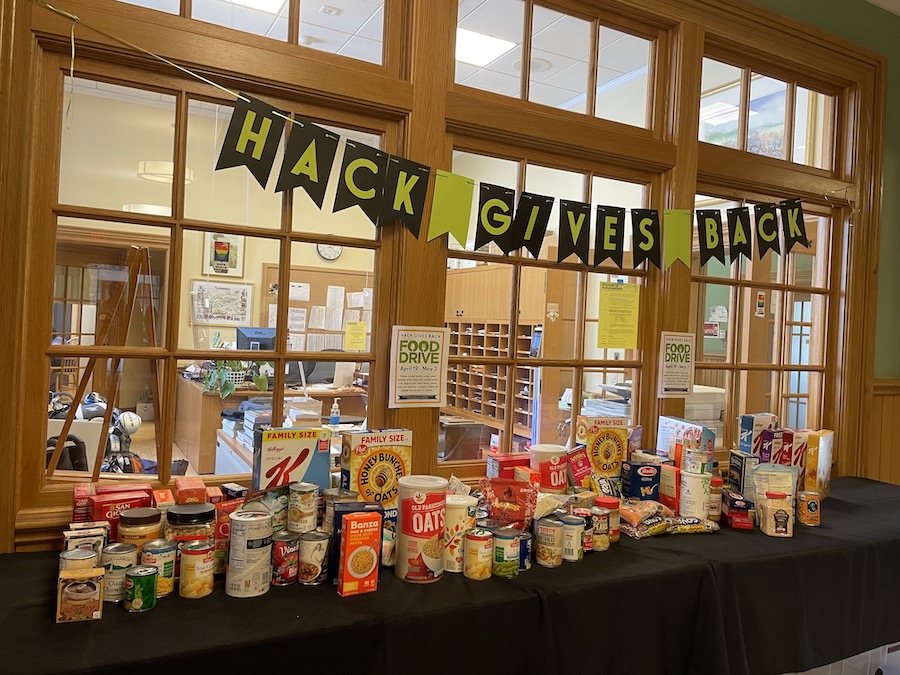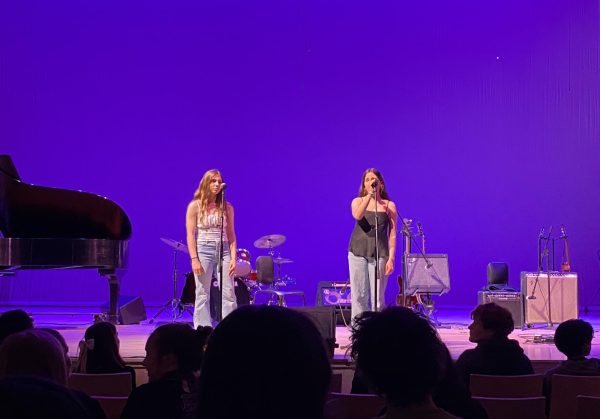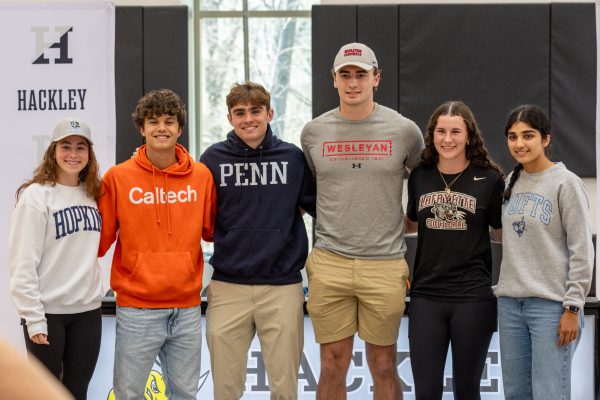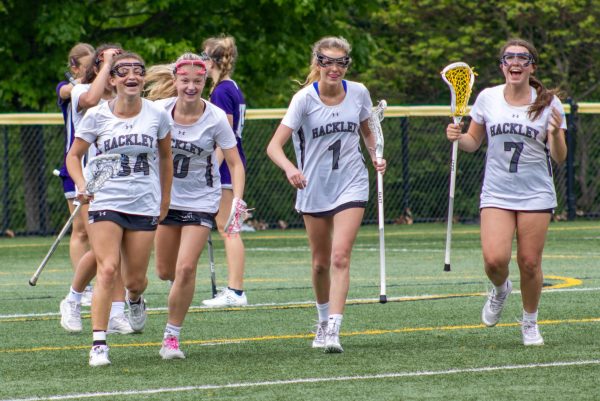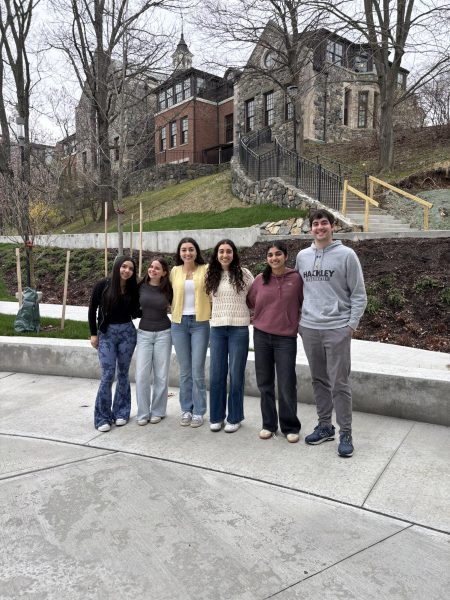Spring Food Drive Focuses on Nutrition
The Hackley Service Team educates the community on food insecurities
Before the COVID-19 pandemic struck, the Community Food Pantry of Sleepy Hollow and Tarrytown helped 200 families a month. Now, they help over 900.
“Food insecurity is a problem that is here,” Lower School Service Coordinator and teacher Mary Murray-Jones said.
This year because of the pandemic, the Hackley Service Team knew they could not tackle a variety of issues like they normally do, so they put their focus on the urgent issue of food insecurity. Their approach this year has been to educate the community so that they can better understand food insecurity and participate in the solution in a more effective way.
Typically in the Lower, Middle, and Upper Schools, students would learn about local food insecurity through hands-on volunteering experiences at soup kitchens and food banks. However, COVID-19 restrictions did not allow for this to happen. Thus, the approach to community service this year has been more educational and a matter of getting information out in digestible ways.
“In my opinion, there has been no greater form of education for students than experiencing food insecurity first hand on-site, and then providing immediate support to those in need the same day,” Middle School service team coordinator and teacher Jennifer Louros said.
Despite not being able to participate in this service engagement experience, “Students have been prompted to be more creative in thinking of ways in which they can continue to serve others while keeping a safe distance, and to understand more clearly that now, more than ever, people are in need of our support,” Ms. Louros said.
This creative thinking came into play prior to the Winter Food Drive, where each division aimed to get the message out and collect as much food as possible.
In the Middle School, students made fliers to help spread the word and raise awareness prior to the Winter Food Drive and prepared announcements for inclusion in the Hornet Weekly.
The Upper School Civic Engagement class, taught by Emily Washington, K-12 Service Learning Coordinator, created an informational video on food insecurity at the local and national level, then took over the Hackley Instagram account to share stories including facts about food insecurity.
Finally, in the Lower School, Ms. Murray Jones coordinated a service team made up of students from second to fourth grades, meeting every other week to work on a plan to advertise information on food insecurity.
Within the service group and in the classroom, Ms. Murray-Jones has encouraged getting conversations going about what exactly food insecurity is, breaking it down into small pieces that students can grasp and understand the issue; “We are asking kids from Kindergarten to fourth grade, what is food insecurity? Is it only affecting people a million miles away from us? No, it is right here,” she said.
A big piece in educating Lower School students on complex issues like this is putting information in their language so they can understand exactly what food insecurity is.
“We are hitting them at the level that they can understand. That is our big approach,” Ms. Murray-Jones said.
For example, to demonstrate the fact that one in ten people are food insecure, Ms. Murray-Jones had ten students together and counted up to the tenth student, saying, “you are the person that would be hungry using the statistics we have in front of us”.
Each division’s efforts proved successful; “The goal was to get the message out, we need to collect food, and that is what we did,” Ms. Murray-Jones said.
Similarly to the service club in the Lower School, Ms. Louros plans to organize a Community Service club in the Middle School next year where a group of students would meet with her weekly to share their ideas for service opportunities, create educational resources to help inform the Hackley community about the reality of the recipients’ needs and then design advertisements to promote the causes.
This is just the tip of the iceberg as more people are involved and collaborating at different divisional levels than ever; From Middle Schoolers watching video presentations and other educational resources on the serious reality of food insecurity that Upper Schoolers have shared with them, to Renee Pabst using the first graders’ healthy food unit to discuss the differences between healthy and unhealthy food, the Hackley community is still finding ways to collaborate.
Recently, Junior Niky Dhakad gave a slide presentation on food insecurities to third and fourth grades.
“In the Winter Food Drive, many unhealthy foods were donated,” Niky said, “Food is food. But if a family can’t get access to healthy food they are at a greater risk for every sort of medical problem and physical and mental health issues.”
Niky talked about the urgency of food insecurity in simple terms that Lower School students could understand, demonstrating how oftentimes to get access to healthy food, people have to give up something else like electricity. He also expressed the need to have an appropriate focus on not just access to food but to healthy, nourishing food. Ms. Murray-Jones presented his ideas to the first grade classes and they were able to understand it well.
“Just getting the terminology out there makes the kids more familiar with food insecurity,” she said.
The Civic Engagement Class for Advanced Spanish Speakers also collaborated with the Lower School, creating a Tik Tok video with kindergarten and second graders to compare foods that provide little in the way of nutrition versus nutrient-dense foods, in preparation for the current Spring Food Drive that has a focus on nutrition.
Middle School students have also had a more hands-on approach to the Spring Food Drive than they had with the previous one. For example, 5th graders have researched about nutrition and what factors to consider when purchasing food items, especially those to contribute to the Food Drive. They have created educational fliers and posters showing our community what to focus their attention on when reading food labels, and how to more easily distinguish between foods of high nutritional value versus those with too many grams of sugar, sodium, and fats.
Ms. Louros expresses that rather than simply asking one’s parents to bring home something from the grocery store to donate as a “check-off” on their To-Do list, it is extremely important to research, listen, and understand the authentic needs of the population who is receiving the donations provided and then to make appropriate choices on how they can contribute their support.
You can participate in the Spring Food Drive by dropping off non-perishable, nutrition-rich food items in the bins and tables at the entrance hallway by the Lower School Office, outside of the main office in the Middle School, and in front of Ms. Coy’s office in the Upper School. The Drive ends on Monday, May 17th, so please use this last opportunity to contribute to the local community!
A focus on nutrition security will help effectively address real solutions that tackle modern-day challenges of diet-related diseases and government assistance, providing not only food but also well-being and health for everyone.

